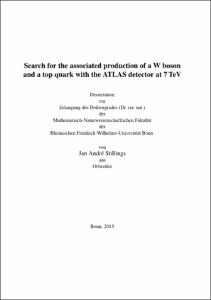Stillings, Jan André: Search for the associated production of a W boson and a top quark with the ATLAS detector at 7 TeV. - Bonn, 2015. - Dissertation, Rheinische Friedrich-Wilhelms-Universität Bonn.
Online-Ausgabe in bonndoc: https://nbn-resolving.org/urn:nbn:de:hbz:5n-40155
Online-Ausgabe in bonndoc: https://nbn-resolving.org/urn:nbn:de:hbz:5n-40155
@phdthesis{handle:20.500.11811/6470,
urn: https://nbn-resolving.org/urn:nbn:de:hbz:5n-40155,
author = {{Jan André Stillings}},
title = {Search for the associated production of a W boson and a top quark with the ATLAS detector at 7 TeV},
school = {Rheinische Friedrich-Wilhelms-Universität Bonn},
year = 2015,
month = jun,
note = {An analysis searching for the associated production of a W boson and a top quark based on 4.7 fb-1 proton collision data recorded by the ATLAS detector at the LHC in 2011 at a centre-of-mass energy of √s = 7 TeV is presented. The weak-force production of single top quarks is of particular interest as it allows a direct access to the properties of the top-quark production vertex, which includes a W boson, a bottom quark and a top quark. The analysed final state, including a single lepton, two light-quark jets and a bottom-quark jet is challenging given the comparably large amount of irreducible backgrounds. This thesis details methods to create single variables which can serve as classifiers to extract signal and background contributions from a fit of simulated templates. One classifier is based on the output of an artificial neural network training using the NeuroBayes software. Furthermore, the combination of two neural network outputs is exploited to enhance shape differences between signal and different background distributions. A binned maximum likelihood fit is used to extract the cross-section of Wt production and its backgrounds and pseudo-experiments are employed to estimate statistical and systematic uncertainties as well as the significance of the measurement. Finally, an iterative procedure is introduced, which improves the expected measurement significance by optimising the choice of input variables to the neural network trainings in terms of both statistical and systematic uncertainties.},
url = {https://hdl.handle.net/20.500.11811/6470}
}
urn: https://nbn-resolving.org/urn:nbn:de:hbz:5n-40155,
author = {{Jan André Stillings}},
title = {Search for the associated production of a W boson and a top quark with the ATLAS detector at 7 TeV},
school = {Rheinische Friedrich-Wilhelms-Universität Bonn},
year = 2015,
month = jun,
note = {An analysis searching for the associated production of a W boson and a top quark based on 4.7 fb-1 proton collision data recorded by the ATLAS detector at the LHC in 2011 at a centre-of-mass energy of √s = 7 TeV is presented. The weak-force production of single top quarks is of particular interest as it allows a direct access to the properties of the top-quark production vertex, which includes a W boson, a bottom quark and a top quark. The analysed final state, including a single lepton, two light-quark jets and a bottom-quark jet is challenging given the comparably large amount of irreducible backgrounds. This thesis details methods to create single variables which can serve as classifiers to extract signal and background contributions from a fit of simulated templates. One classifier is based on the output of an artificial neural network training using the NeuroBayes software. Furthermore, the combination of two neural network outputs is exploited to enhance shape differences between signal and different background distributions. A binned maximum likelihood fit is used to extract the cross-section of Wt production and its backgrounds and pseudo-experiments are employed to estimate statistical and systematic uncertainties as well as the significance of the measurement. Finally, an iterative procedure is introduced, which improves the expected measurement significance by optimising the choice of input variables to the neural network trainings in terms of both statistical and systematic uncertainties.},
url = {https://hdl.handle.net/20.500.11811/6470}
}






